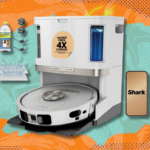
NASA says its first mission to intentionally crash a spacecraft into an asteroid succeeded in dramatically altering its path, proving the agency is capable of thwarting a potential hazardous space rock in the future, should one be on a collision course with Earth.
The crash into the asteroid, Dimorphos, happened on Sept. 26, 2022, but scientists didn’t know whether they actually moved it until now. Astronomers used ground telescopes to study its orbit around a larger asteroid, Didymos, and found the loop was sped up from 11 hours and 55 minutes to 11 hours and 23 minutes, an impressive change of 32 minutes. Mission operations leaders said they only needed to observe a change of 73 seconds to confirm the Double Asteroid Redirection Test, better known as DART, worked.
NASA administrator Bill Nelson called it « a watershed moment for planetary defense, and a watershed moment for humanity » during a news conference on Tuesday, Oct. 11, 2022.
The Johns Hopkins Applied Physics Laboratory in Maryland broadcast the $330 million carefully orchestrated collision two weeks ago, giving viewers a deer-in-headlights experience. Through a camera on the spacecraft, the team of scientists and engineers, as well as the general public, were able to watch a stadium-sized rock grow from a mere dot of light to a rocky egg-shaped boulder blotting out the entire frame. The feed almost unfolded in real time, with around just a 45-second delay, delivering an extreme closeup of an event happening 6.8 million miles away.
The spacecraft, about 1,300 pounds, carried no explosives. Its « weapon » was its own body and the sheer force of plowing into an asteroid at 14,000 mph.
Scientists have likened the mission to running a golf cart into the Great Pyramid of Giza. The spacecraft’s nudge left a crater behind but didn’t blow the asteroid to bits. The LICIACube, a toaster-sized spacecraft supplied by the Italian Space Agency, has flown by the disaster site and taken pictures of the results.
« a watershed moment for planetary defense, and a watershed moment for humanity … »
NASA chose Dimorphos for the mission because it was an ideal specimen for tracking the results of DART’s hit. It has likely had the same orbit, looping around a larger asteroid, Didymos, for thousands of years — until now.
Millions of space rocks orbit the sun. The majority are in the main asteroid belt between Mars and Jupiter, but occasionally rocks get nudged into the inner solar system, relatively closer to Earth.
There are currently no known asteroids on an impact course with our planet. Scientists are, however, keeping a vigilant eye on 30,000 large objects in Earth’s solar system neighborhood and estimate there could be around 15,000 asteroids larger than 460 feet across waiting to be discovered. Using powerful telescopes, these astronomers are currently finding around 500 new sizable space rocks near Earth (which means passing within some 30 million miles of our planet’s orbit) each year.
But even smaller rocks can cause immense destruction. An impact by an asteroid some 100 to 170 feet wide would destroy a place like Kansas City. An undetected meteor exploded over Chelyabinsk, Russia, in February 2013, causing an airburst and shockwave that affected six cities and injured 1,600 people. The rock was just 60 feet across, according to NASA.
This is a developing story. Check back for updates.




